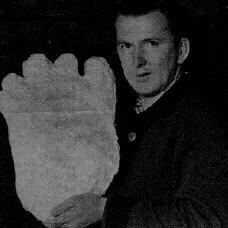


 War of the Giants
War of the Giants 
Chapter 5
Out of the dawn of, monstrous ape-men of Aboriginal myth and legend. They haunted the more remote, mountainous forest recesses of the Australian continent, as well as the inhospitable open country of the vast interior. They are known to every Aboriginal across the continent by many names, and take a number of different forms. They are the Giants of the Dreamtime, races of giant hominids that roamed the continent even long before the appearance of the first Aborigines.
They are the 'megastralian' monster men of both myth and reality who come from a time, lost so far back in the mists of the past that their origins can at present only be guessed at. Yet they lived, for they have left evidence of their former presence, in the folklore of our Aborigines, as well as in their massive stone implements scattered across the country, and in the often monstrous footprints they left, to fossilise into rock as they journeyed across the landscape of this timeless land.
The traditions of the Yowie are forever bound up with these monstrous beings, both giant man-like and ape-like, which the Aborigines often collectively distinguished from the normal 'hairy man' or Yowie, by the name "great hairy man". If certain myths and legends of our Aboriginal people are based upon factual events in the dim past, this continent was the scene of great stone-age wars.
The evidence for these often titanic and bloody battles is still to be found scattered across the landscape. It consists of gigantic natural features, concentrations of megatools, and outcrops of boulders varying from very large to monolithic. To Aborigines they mark the battle grounds where once their forefathers fought stone-age titans for the domination of the continent. Aboriginal wars were by no means confined to eradicating giant hominids, for their enemies included the pygmy folk and other, normal human-sized primitives; and there were also frequent internal wars fought among the Aborigines themselves.
This great struggle had continued unabated over eons and was in progress long before the advent of the Aborigines. "Dawn hominids' were fighting one another across Pliocene-Pleistocene Australia, in scenes of group violence no different from those being acted out on the plains of Africa and Asia at about the same time. These wars of the Australian dream-time live on in Aboriginal tradition, so that today, through their myths and legends, we can reconstruct a general picture of this vast ice-age struggle, which, although long known to our Aboriginal people, has remained largely overlooked by prehistory researchers.
The Blue Mountains region west of Sydney, possesses a number of sometimes gigantic rock formations venerated by the tribes of long ago as giant beings of the dream-time. 19th century Blue Mountains settlers were informed by Dharuk tribesmen, that the monolithic formation rising up out of the Jamieson Valley south of Katoomba[ itself the scene of fierce battles with the Jogung giants in the dream-time], and now known as Mt Solitary, was in reality a sleeping giant male ancestral being.
The formation, which extends east-west across the valley, does give the impression of a reclining giant human figure; its eastern cliffs outline resembling a head with a prominent nose, and a flowing beard descending eastwards in the form a ridge, down into the valley. The name "Sleeping Giant" for this mountain, lived on well into the 20th century among aging residents. The "Sleeping Giant" tradition is reminiscent of the "Sleeping Giant Woman of Currabubula", south of Tamworth, in northern NSW. The formation, once the subject of many discussions among early settlers, but now largely forgotten, can be observed by following the horizon outline of the mountains behind Currabubula.
It is best seen from Timbumburi far to the east; the head with long flowing hair, breast and body being clearly outlined. The formation was, according to the Kamilaroi Aboriginal tribe which formerly roamed the whole of the New England region, a female Goolagah giant that had fallen asleep in the dream-time. Early settlers were warned that she would wake up someday and wreak havoc on the surrounding countryside.
To the Wiradjuri tribesmen of the Bathurst district, [west of the Blue Mountains and north of the vast Kanangra Boyd wilderness] two mountain peaks not far from Oberon [which lies just north of the Kanangra forest country] were in reality the breasts of a gigantic "Bulloo woman". 'Bulloo' was yet another name for the giant tool-making hominids to the Aborigines of this region, and it is significant that the first stone megatools found by this author were unearthed hereabouts, as stated in the previous chapter.
The normal height of the Bulloo, as suggested by the sizes and weights of their stone implements and fossil footprints, was around 3-4 m, and further west of Bathurst they were also known as the Bullai and Bahloo. Myth could also make them of truly gigantuan height and proportions, as in the case of the Wallu-Barl [another variation of Bulloo] giants of the Darling River country, who were "taller than the tallest trees".
They ate everything and anything, including the Bakandji tribespeople who lived along the river. Groups of Wallu-Barl also fought each other, with mighty stone and wooden weapons, hurling massive stone boulders about the land. They strode about the countryside, driving out the Aborigines wherever they settled. But there came a time when the river and all the water holes dried up and the land became parched. Many Wallu-Barl died of thirst, except for the smarter Aboriginal people for they knew how to find water beneath the ground. The surviving Wallu-Barl were attacked and killed with spears by the Bakandji warriors.

















